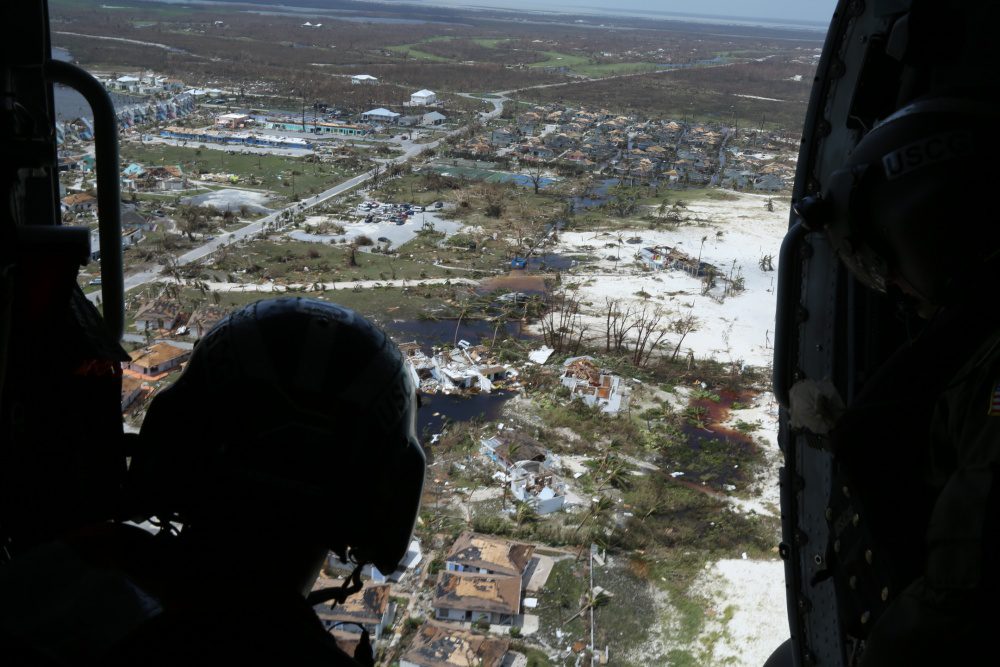Petty Officer 2nd Class Mike Lewis observes the damages in support of search and rescue and humanitarian aid in the Bahamas, Sept. 4, 2019. U.S. Coast Guard Photo

By Nick Brown NASSAU, Bahamas, Sept 5 (Reuters) – An international relief effort to bring humanitarian aid to stunned residents of the Bahamas gathered pace on Thursday as Hurricane Dorian churned northward off the coast of South Carolina, threatening storm surges and flooding.
Aerial video of the worst-hit Abaco Islands in the northern Bahamas showed widespread devastation, with the harbor, shops, workplaces, a hospital and airport landing strips damaged or decimated, frustrating rescue efforts.
The United Nations estimated more than 76,000 people were in need of humanitarian relief after the most damaging storm ever to hit the island nation.
The U.N. World Food Programme (WFP) said it bought 8 metric tonnes of ready-to-eat meals and was organizing an airlift from Panama of storage units, generators and prefab offices for two logistics hubs, as well as satellite equipment for emergency responders.
The U.N. agency has allocated $5.4 million to a three-month emergency operation to support 39,000 people, said Hervé Verhoosel, senior WFP spokesperson.
“In a first phase, WFP will focus on the immediate procurement and distribution of up to 85 MT of ready-to-eat meals for the most affected communities,” Verhoosel said.
Dorian was rated a Category 5 hurricane when it killed at least 20 people in the Bahamas. Authorities expect that number to rise, Prime Minister Hubert Minnis said at a news briefing, as retreating floodwaters revealed the scope of destruction.
One of the storm survivors on the Abaco Islands, Ramond King, said he watched as swirling winds ripped the roof off his house, then churned to a neighbor’s home to pluck the entire structure into the sky.
“‘This can’t be real, this can’t be real’,” King recalled thinking. “Nothing is here, nothing at all. Everything is gone, just bodies.”
Total insured and uninsured losses in the Bahamas amounted to $7 billion, including buildings and business interruptions, according to a preliminary estimate by Karen Clark & Co, a consultancy that provides catastrophic modeling and risk management services.
With telephones down in many areas, residents posted lists of missing loved ones on social media. One Facebook post by media outlet Our News Bahamas had 2,500 comments, mainly listing lost family members.
Dorian killed one person in Puerto Rico before hovering over the Bahamas for two days with torrential rains and fierce winds that whipped up 12- to 18-foot (3.7- to 5.5-meter) storm surges.
POSSIBLE RECORD SURGE
The hurricane was barreling north-northeast just off the southeastern U.S. coast on Thursday, moving at about 7 miles per hour (11 kph), with maximum sustained winds fluctuating between 110 and 115 mph (175-185 kph), between a Category 2 and Category 3 storm on the five-point Saffir-Simpson wind scale.
The storm was about 50 miles (80 km) east-southeast of flood-prone Charleston, South Carolina, at 11:30 a.m. EST (1500 GMT), the U.S. National Hurricane Center said.
“Whether it makes landfall or not, you still have the core winds right around the center,” NHC Director Ken Graham said from the agency’s headquarters in Miami.
“So wherever those make it on shore, you can still have some significant hurricane force winds.”
More than 2.2 million people in Florida, Georgia, North Carolina and South Carolina had been ordered to evacuate, although Florida avoided a direct hit.
The forecast called for the storm to move northeast along North Carolina’s Outer Banks, a popular coastal vacation spot, by Friday afternoon and then out to sea. The NHC also added a tropical storm warning for coastal Virginia, including the Norfolk-Virginia Beach area.
Parts of the Carolinas would get 6 to 10 inches (15 to 25 cm) of rain, with some areas topping out at 10-15 inches (25 to 38 cm). Storm surge was forecast at 5 to 8 feet (1.5 to 2.4 meters) in Myrtle Beach, South Carolina.
More than 239,000 homes and businesses in the U.S. Southeast were without power, according to local electric companies.
RELIEF EFFORTS
A flight from the U.S. Agency for International Development landed in the Bahamas early on Thursday with enough relief supplies to help 31,500 people, bringing hygiene kits, water containers and buckets, plastic sheeting and chain saws.
Also arriving was a disaster assistance response team (DART) plane that included a fire and rescue team from Fairfax County, Virginia, to help the authorities search for survivors, USAID’s Office of Foreign Disaster Assistance said on Twitter.
A British Royal Navy vessel was providing assistance, and Jamaica was sending a 150-member military contingent to help secure Abaco and Grand Bahama, officials said.
Volunteers also ferried supplies to the islands in a flotilla of small boats.
As many as 13,000 homes in the Bahamas may have been destroyed or severely damaged, the International Federation of Red Cross and Red Crescent Societies said.
(Reporting by Nick Brown in Nassau, Bahamas, additional reporting by Nick Carey in Charleston, South Carolina, Alex Dobuzinskis in Los Angeles, Rebekah Ward in Mexico City, Andrew Hay in Taos, New Mexico and Rich McKay in Atlanta, writing by Scott Malone and Sonya Hepinstall; Editing by Bernadette Baum and Cynthia Osterman)
(c) Copyright Thomson Reuters 2019.

 Join The Club
Join The Club











